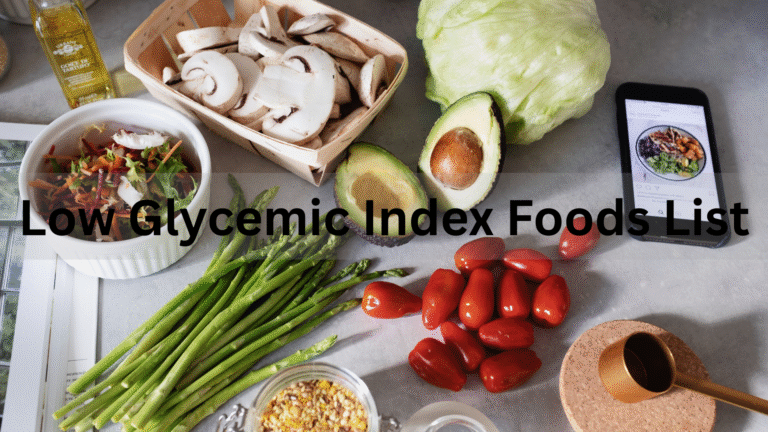Have you ever felt a sudden energy crash after eating something sweet or processed? That’s because your blood sugar levels spiked and then dropped rapidly. The secret to avoiding those ups and downs is to eat low glycemic index (GI) foods ,the kind of foods that release energy slowly, keeping you full and energized for longer periods.
Low GI eating isn’t just for diabetics ,it’s beneficial for anyone looking to maintain steady energy, control appetite, and improve metabolic health. In this article, we’ll break down what low GI foods are, why they matter, and provide a detailed list of the best options to include in your daily diet.
What Is the Glycemic Index (GI)?
The glycemic index is a scientific system that measures how quickly a carbohydrate-containing food raises your blood sugar after eating. Developed in the early 1980s by Dr. David Jenkins, it gives each food a score between 0 and 100 ,with glucose (pure sugar) at 100.
This tool helps people understand which foods have a rapid or gradual impact on blood glucose. The goal? To eat more foods that cause a slow, steady rise in sugar levels instead of sharp spikes.
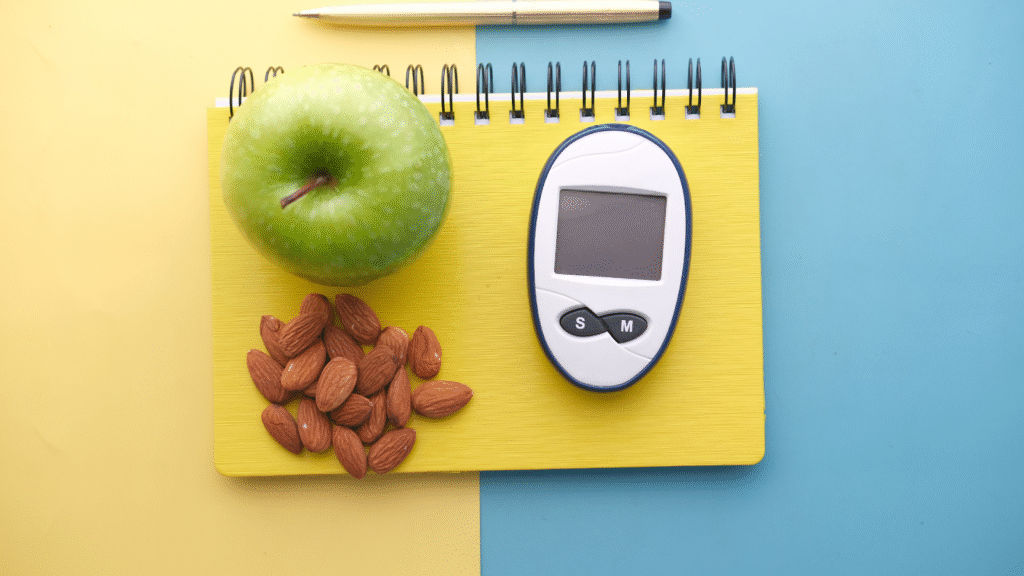
How the Glycemic Index Works
When you consume carbohydrates, they break down into glucose, the body’s primary energy source. Foods with high GI values are digested quickly, causing a surge in blood sugar. Conversely, low GI foods digest slowly, providing a sustained energy release.
Factors that influence GI include:
- The type of carbohydrate (simple vs. complex)
- The presence of fiber, fat, or protein (which slows digestion)
- Cooking methods (boiling vs. baking)
- The ripeness of fruits ,ripe bananas have higher GI than unripe ones
Understanding Low, Medium, and High GI Foods
The GI scale divides foods into three categories:
- Low GI (1–55): Slow digestion, gradual energy release (e.g., oats, beans, apples)
- Medium GI (56–69): Moderate digestion rate (e.g., sweet corn, brown rice)
- High GI (70 and above): Fast digestion, rapid energy spike (e.g., white bread, potatoes)
Low GI foods are recommended because they prevent insulin spikes, enhance satiety, and help control cravings.
Why You Should Eat Low Glycemic Index Foods
Low GI foods offer multiple benefits beyond controlling blood sugar. Here’s why they should be a staple in your diet:
- Stable Blood Sugar Levels – Prevents sudden drops and sugar cravings.
- Sustained Energy – Keeps you active and focused throughout the day.
- Weight Management – Reduces hunger, making calorie control easier.
- Improved Heart Health – Lowers cholesterol and triglycerides.
- Better Metabolic Health – Reduces the risk of insulin resistance and diabetes.
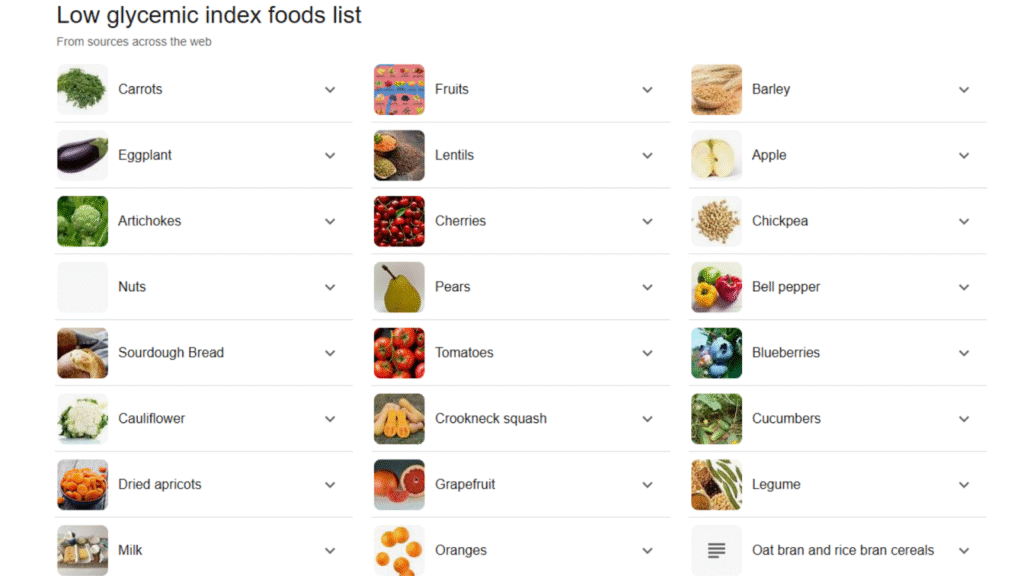
Comprehensive Low Glycemic Index Foods List
Fruits (Low GI)
| Fruit | GI Value |
| Cherries | 22 |
| Grapefruit | 25 |
| Pears | 38 |
| Apples | 38 |
| Oranges | 40 |
| Plums | 24 |
| Peaches | 42 |
Vegetables (Low GI)
| Vegetable | GI Value |
| Broccoli | 10 |
| Spinach | 15 |
| Carrots | 35 |
| Cauliflower | 15 |
| Lettuce | 10 |
| Zucchini | 15 |
Whole Grains
| Grain | GI Value |
| Barley | 28 |
| Quinoa | 53 |
| Bulgur | 48 |
| Rolled Oats | 55 |
| Buckwheat | 49 |
Legumes
| Legume | GI Value |
| Lentils | 32 |
| Chickpeas | 33 |
| Black beans | 30 |
| Kidney beans | 29 |
| Navy beans | 31 |
Dairy & Alternatives
| Product | GI Value |
| Milk | 34 |
| Yogurt | 35 |
| Soy milk | 34 |
| Almond milk | 25 |
Nuts & Seeds
| Type | GI Value |
| Almonds | 15 |
| Walnuts | 15 |
| Cashews | 25 |
| Chia seeds | 1 |
| Flaxseeds | 5 |
Protein Sources
| Source | GI Value |
| Eggs | 0 |
| Chicken | 0 |
| Fish | 0 |
| Tofu | 15 |
Detailed Breakdown of Low GI Fruits
Low GI fruits like apples, cherries, and pears provide natural sweetness without causing blood sugar surges. They are high in fiber, antioxidants, and vitamins that improve digestion and support heart health.
Tip: Pair fruits with nuts or yogurt for a balanced snack that keeps sugar absorption slow and steady.
Low GI Vegetables and Their Role in Diet
Non-starchy vegetables such as broccoli, spinach, and cauliflower are low in carbohydrates and high in fiber. They’re essential for maintaining gut health and promoting weight control.
Example: Add steamed vegetables to meals instead of fries or mashed potatoes for better blood sugar stability.
Low GI Whole Grains for Lasting Energy
Whole grains are packed with complex carbs, fiber, and protein that digest slowly. This results in longer satiety and improved metabolism.
Examples: Barley porridge, quinoa salad, and oatmeal make excellent breakfast or lunch options.
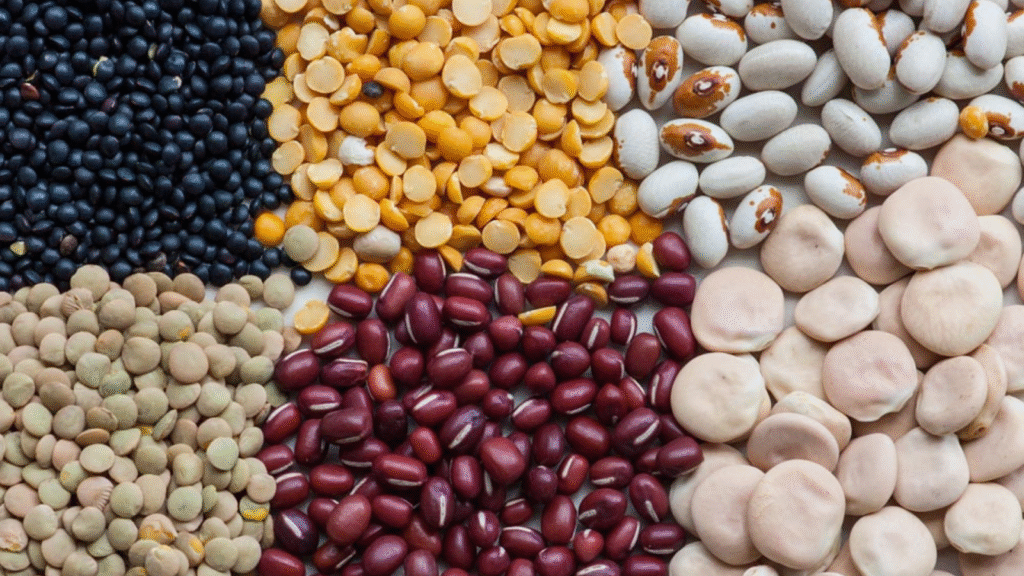
Legumes: Nutrient-Dense and Low GI
Legumes such as chickpeas, lentils, and beans are ideal for anyone managing blood sugar or trying to eat more plant-based meals. They’re loaded with plant protein, iron, and folate, and their fiber content slows glucose release.
Pro Tip: Replace meat in curries or salads with lentils for a filling, low-GI protein source.
Low GI Dairy and Plant-Based Alternatives
Dairy products like milk and yogurt have moderate GI levels due to their protein and fat balance. Unsweetened soy and almond milk are great alternatives for those avoiding lactose or reducing sugar intake.
Quick tip: Choose plain yogurt and add fresh fruit for natural sweetness.
Incorporating Low GI Foods into Everyday Meals
- Breakfast: Oatmeal with berries and chia seeds
- Lunch: Lentil salad with spinach and quinoa
- Snack: Apple slices with almond butter
- Dinner: Grilled fish with steamed vegetables and barley
These meals are delicious, balanced, and designed to maintain steady blood glucose levels throughout the day.
Health Benefits of Low GI Foods
- Helps Manage Diabetes – Keeps blood sugar within safe limits.
- Supports Heart Health – Reduces cholesterol and triglycerides.
- Aids Weight Loss – Encourages fat burning and controls appetite.
- Boosts Energy Levels – Prevents energy crashes after meals.
- Improves Mental Focus – Stable glucose means better concentration.
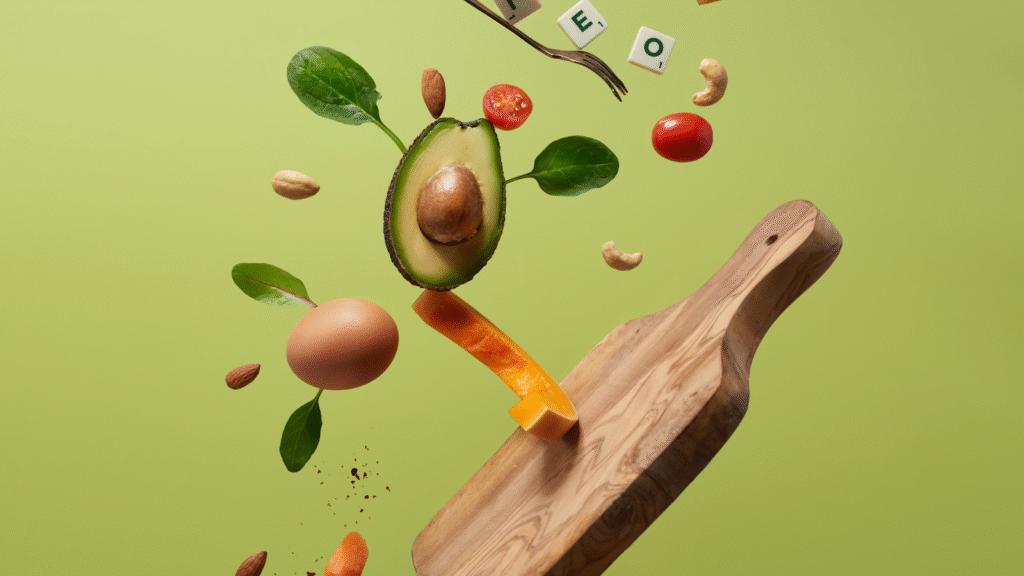
Common Misconceptions About Low GI Diets
- Myth 1: Low GI foods are always healthy.
Truth: Some low GI foods, like chocolate, are calorie-dense and should be eaten in moderation. - Myth 2: You can’t eat carbs on a low GI diet.
Truth: You can just choose complex carbs such as oats, legumes, and whole grains. - Myth 3: GI is the only thing that matters.
Truth: Portion size, overall diet quality, and preparation methods are equally important.
Practical Tips for Maintaining a Low GI Lifestyle
- Combine carbs with protein or fats to slow digestion.
- Cook grains al dente for lower GI values.
- Choose fresh over processed foods.
- Avoid sugary beverages.
- Read food labels carefully to spot hidden sugars.
Conclusion
Eating low glycemic index foods is one of the simplest yet most effective ways to improve your overall health. From controlling blood sugar to maintaining energy and supporting weight management, low GI foods make a real difference in how you feel every day.
Start small ,switch white bread for whole-grain, choose lentils over rice, or add more vegetables to your meals. These gradual steps can transform your energy, focus, and long-term health.


